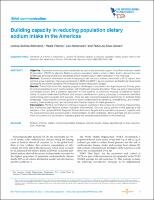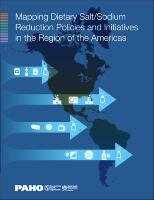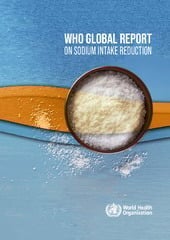Cardiovascular diseases (CVDs) are the leading cause of death in the world, and high blood pressure is the leading risk factor for CVD morbidity, mortality, and disability. Indeed, excessive salt/sodium intake adversely affects blood pressure.
Aligned with WHO Global Action Plan on NCDs 2013-2020, the PAHO Plan of Action for the Prevention and Control of NCDs 2013-2019 has proposed a 30% relative reduction in the mean salt/sodium intake in the population, with the aim of achieving a target of salt intake per person fewer than 5 grams per day (2 grams of sodium) by 2030. Member States have also agreed on a voluntary global NCD target for a 25% reduction in the prevalence of raised blood pressure (defined as systolic blood pressure ≥140 mmHg and/or diastolic blood pressure ≥90 mmHg) relative to its value in 2010, by 2025.
Identified as a “Best Buy”, reducing dietary salt/sodium intake at the population level is cost-effective, with potential for measurable and meaningful impact on reducing NCD burden, particularly premature mortality from ischemic heart disease and stroke. To this end, the Pan American Health Organization (PAHO) has launched a region-wide action –Cardiovascular Disease Prevention through Dietary Salt Reduction– intended to implement population-level cost-effective interventions for reducing salt/sodium intake and improving population health.
In this context, PAHO is mapping existing country policies and initiatives addressing population dietary salt/sodium reduction in the Region of the Americas; identifying policy gaps according to outlined WHO "Best Buys" interventions for the prevention and control of diet-related NCDs; making available a repository of policies, laws, and regulations to reduce salt/sodium intake in the population; and using data on policy gaps to discuss priorities in the region.
This interactive tool allows you to explore data and information regarding the existing national policies and initiatives addressing dietary salt/sodium intake reduction in the population, monitor the implementation of cost-effective "Best Buys" interventions, and adoption of legislation and policies for the reduction of salt/sodium intake at the population level, and provide information on policy gaps to prioritize actions.
Methods and sources.
Data were collected through a structured review, of mostly national official sources, to identify current policies and initiatives in place to reduce population salt/sodium intake.
Key sources included:
- responses from the online Survey on National Initiatives for Salt/Sodium Reduction in the Americas carried out by the Pan American Health Organization (PAHO) in 2016;
- database from the 2017 and 2019 PAHO Country Capacity Survey for NCDs and Risk Factors;
- the repositories of legislation of the PAHO REGULA initiative as of 2018;
- electronic searches between January 2018 to April 2019 of official websites from the ministries of health, education, and agriculture, the library of national congress in each country, and government regulatory gazettes.
- information obtained from a meeting in early 2016 of the Technical Advisory Group (TAG) guiding Phase III of the regional salt reduction initiative.
WHO "Best Buys" to reduce unhealthy diet.
- Reduce salt intake through the reformulation of food products to contain less salt and the setting of target levels for the amount of salt in foods and meals.
- Reduce salt intake through the establishment of a supportive environment in public institutions such as hospitals, schools, workplaces, and nursing homes, to enable lower sodium options to be provided.
- Reduce salt intake through a behavior change communication and mass media campaign.
- Reduce salt intake through the implementation of front-of-pack labeling.
Detailed information about the salt/sodium intake reduction policies can be found in the technical and scientific publication section.
Results.
Out of 34 countries,
- 11 countries have implemented voluntary policies to reduce sodium content in food products versus 2 that have enacted mandatory sodium content targets;
- 13 countries have established healthier food environments in public institutions, and at least 26 countries had consumer awareness programs in place;
- no country had implemented behavior change communication and mass-media campaigns at the national level; and
- 5 countries had implemented front-of-package labeling policies for products high in salt/sodium and marketing restrictions for such products when targeted at children.
- No country has implemented taxation on products high in salt.
Despite progress, challenges to succeed in this agenda persist. Priority given to sodium reduction is low in most countries, with insufficient resource allocation. There is a lack of intersectoral coordinated action, and a systemic approach to food systems is commonly missing. Surveillance mechanisms of sodium intake are insufficient, and industry interference in policy processes is commonly identified, undermining policy progress and success.
There are also important regional opportunities to address these challenges. These include common ground for future collaborations by updating, strengthening, and complementing these existing tools, and technical and financial support for data generation.
Conclusions.
PAHO is committed to continue supporting countries in the process of promoting, implementing, and monitoring cost-effective sodium reduction interventions. One key policy priority in this agenda is the adoption of the Updated PAHO Regional Sodium Reduction Targets with a mandatory approach, together with the comprehensive and complementary implementation of other strategies. Strong political will and commitment of countries will be critical to translate goals into concrete achievements in the Americas.
Suggested citation.
Salt/sodium intake reduction policies in countries of the Americas, ENLACE data portal. Pan American Health Organization. 2022 [Internet] Available online at https://www.paho.org/en/enlace/saltsodium-intake-reduction-policies






